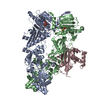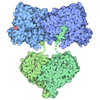+ Open data
Open data
- Basic information
Basic information
| Entry | Database: PDB / ID: 8eoa | ||||||
|---|---|---|---|---|---|---|---|
| Title | Cryo-EM structure of human HSP90B-AIPL1 complex | ||||||
 Components Components |
| ||||||
 Keywords Keywords | CHAPERONE / HSP90B / AIPL1 / phosphodiesterase 6 | ||||||
| Function / homology |  Function and homology information Function and homology informationfarnesylated protein binding / HSP90-CDC37 chaperone complex / regulation of opsin-mediated signaling pathway / negative regulation of proteasomal protein catabolic process / Aryl hydrocarbon receptor signalling / aryl hydrocarbon receptor complex / histone methyltransferase binding / dynein axonemal particle / receptor ligand inhibitor activity / protein kinase regulator activity ...farnesylated protein binding / HSP90-CDC37 chaperone complex / regulation of opsin-mediated signaling pathway / negative regulation of proteasomal protein catabolic process / Aryl hydrocarbon receptor signalling / aryl hydrocarbon receptor complex / histone methyltransferase binding / dynein axonemal particle / receptor ligand inhibitor activity / protein kinase regulator activity / ATP-dependent protein binding / positive regulation of protein localization to cell surface / retina homeostasis / protein folding chaperone complex / Respiratory syncytial virus genome replication / telomerase holoenzyme complex assembly / positive regulation of transforming growth factor beta receptor signaling pathway / Uptake and function of diphtheria toxin / dendritic growth cone / TPR domain binding / Assembly and release of respiratory syncytial virus (RSV) virions / The NLRP3 inflammasome / protein phosphatase activator activity / phototransduction, visible light / Sema3A PAK dependent Axon repulsion / regulation of protein ubiquitination / HSF1-dependent transactivation / response to unfolded protein / HSF1 activation / Attenuation phase / chaperone-mediated protein complex assembly / telomere maintenance via telomerase / axonal growth cone / RHOBTB2 GTPase cycle / Purinergic signaling in leishmaniasis infection / : / DNA polymerase binding / heat shock protein binding / supramolecular fiber organization / negative regulation of proteasomal ubiquitin-dependent protein catabolic process / photoreceptor inner segment / protein folding chaperone / peptide binding / cellular response to interleukin-4 / ESR-mediated signaling / HSP90 chaperone cycle for steroid hormone receptors (SHR) in the presence of ligand / placenta development / nitric-oxide synthase regulator activity / positive regulation of cell differentiation / peptidyl-prolyl cis-trans isomerase activity / ATP-dependent protein folding chaperone / DDX58/IFIH1-mediated induction of interferon-alpha/beta / Regulation of actin dynamics for phagocytic cup formation / kinase binding / tau protein binding / histone deacetylase binding / Chaperone Mediated Autophagy / positive regulation of nitric oxide biosynthetic process / disordered domain specific binding / MHC class II protein complex binding / The role of GTSE1 in G2/M progression after G2 checkpoint / unfolded protein binding / melanosome / protein folding / double-stranded RNA binding / regulation of protein localization / cellular response to heat / secretory granule lumen / Estrogen-dependent gene expression / ficolin-1-rich granule lumen / Potential therapeutics for SARS / regulation of cell cycle / protein dimerization activity / protein stabilization / nuclear speck / cadherin binding / neuronal cell body / apoptotic process / ubiquitin protein ligase binding / Neutrophil degranulation / protein kinase binding / negative regulation of apoptotic process / virion attachment to host cell / perinuclear region of cytoplasm / SARS-CoV-2 activates/modulates innate and adaptive immune responses / cell surface / protein homodimerization activity / protein-containing complex / ATP hydrolysis activity / mitochondrion / RNA binding / extracellular exosome / extracellular region / nucleoplasm / ATP binding / identical protein binding / nucleus / membrane / plasma membrane / cytoplasm Similarity search - Function | ||||||
| Biological species |  Homo sapiens (human) Homo sapiens (human) | ||||||
| Method | ELECTRON MICROSCOPY / single particle reconstruction / cryo EM / Resolution: 3.9 Å | ||||||
 Authors Authors | Srivastava, D. / Artemyev, N.O. | ||||||
| Funding support |  United States, 1items United States, 1items
| ||||||
 Citation Citation |  Journal: Structure / Year: 2023 Journal: Structure / Year: 2023Title: Unique interface and dynamics of the complex of HSP90 with a specialized cochaperone AIPL1. Authors: Dhiraj Srivastava / Ravi P Yadav / Sneha Singh / Kimberly Boyd / Nikolai O Artemyev /  Abstract: Photoreceptor phosphodiesterase PDE6 is central for visual signal transduction. Maturation of PDE6 depends on a specialized chaperone complex of HSP90 with aryl hydrocarbon receptor-interacting ...Photoreceptor phosphodiesterase PDE6 is central for visual signal transduction. Maturation of PDE6 depends on a specialized chaperone complex of HSP90 with aryl hydrocarbon receptor-interacting protein-like 1 (AIPL1). Disruption of PDE6 maturation underlies a severe form of retina degeneration. Here, we report a 3.9 Å cryoelectron microscopy (cryo-EM) structure of the complex of HSP90 with AIPL1. This structure reveals a unique interaction of the FK506-binding protein (FKBP)-like domain of AIPL1 with HSP90 at its dimer interface. Unusually, the N terminus AIPL1 inserts into the HSP90 lumen in a manner that was observed previously for HSP90 clients. Deletion of the 7 N-terminal residues of AIPL1 decreased its ability to cochaperone PDE6. Multi-body refinement of the cryo-EM data indicated large swing-like movements of AIPL1-FKBP. Modeling the complex of HSP90 with AIPL1 using crosslinking constraints indicated proximity of the mobile tetratricopeptide repeat (TPR) domain with the C-terminal domain of HSP90. Our study establishes a framework for future structural studies of PDE6 maturation. | ||||||
| History |
|
- Structure visualization
Structure visualization
| Structure viewer | Molecule:  Molmil Molmil Jmol/JSmol Jmol/JSmol |
|---|
- Downloads & links
Downloads & links
- Download
Download
| PDBx/mmCIF format |  8eoa.cif.gz 8eoa.cif.gz | 298.8 KB | Display |  PDBx/mmCIF format PDBx/mmCIF format |
|---|---|---|---|---|
| PDB format |  pdb8eoa.ent.gz pdb8eoa.ent.gz | 232.8 KB | Display |  PDB format PDB format |
| PDBx/mmJSON format |  8eoa.json.gz 8eoa.json.gz | Tree view |  PDBx/mmJSON format PDBx/mmJSON format | |
| Others |  Other downloads Other downloads |
-Validation report
| Summary document |  8eoa_validation.pdf.gz 8eoa_validation.pdf.gz | 1.3 MB | Display |  wwPDB validaton report wwPDB validaton report |
|---|---|---|---|---|
| Full document |  8eoa_full_validation.pdf.gz 8eoa_full_validation.pdf.gz | 1.3 MB | Display | |
| Data in XML |  8eoa_validation.xml.gz 8eoa_validation.xml.gz | 126.7 KB | Display | |
| Data in CIF |  8eoa_validation.cif.gz 8eoa_validation.cif.gz | 233.3 KB | Display | |
| Arichive directory |  https://data.pdbj.org/pub/pdb/validation_reports/eo/8eoa https://data.pdbj.org/pub/pdb/validation_reports/eo/8eoa ftp://data.pdbj.org/pub/pdb/validation_reports/eo/8eoa ftp://data.pdbj.org/pub/pdb/validation_reports/eo/8eoa | HTTPS FTP |
-Related structure data
| Related structure data |  28332MC  8eobC M: map data used to model this data C: citing same article ( |
|---|---|
| Similar structure data | Similarity search - Function & homology  F&H Search F&H Search |
- Links
Links
- Assembly
Assembly
| Deposited unit | 
|
|---|---|
| 1 |
|
- Components
Components
| #1: Protein | Mass: 87170.227 Da / Num. of mol.: 2 Source method: isolated from a genetically manipulated source Source: (gene. exp.)  Homo sapiens (human) / Gene: HSP90AB1, HSP90B, HSPC2, HSPCB / Production host: Homo sapiens (human) / Gene: HSP90AB1, HSP90B, HSPC2, HSPCB / Production host:  #2: Protein | | Mass: 40763.543 Da / Num. of mol.: 1 Source method: isolated from a genetically manipulated source Source: (gene. exp.)   #3: Chemical | #4: Chemical | Has ligand of interest | N | |
|---|
-Experimental details
-Experiment
| Experiment | Method: ELECTRON MICROSCOPY |
|---|---|
| EM experiment | Aggregation state: PARTICLE / 3D reconstruction method: single particle reconstruction |
- Sample preparation
Sample preparation
| Component | Name: HSP90B/AIPL1 complex / Type: COMPLEX / Entity ID: #1-#2 / Source: RECOMBINANT | ||||||||||||||||
|---|---|---|---|---|---|---|---|---|---|---|---|---|---|---|---|---|---|
| Molecular weight | Value: 0.215 MDa / Experimental value: NO | ||||||||||||||||
| Source (natural) | Organism:  Homo sapiens (human) Homo sapiens (human) | ||||||||||||||||
| Source (recombinant) | Organism:  | ||||||||||||||||
| Buffer solution | pH: 7.5 / Details: 25 mM HEPES, 200 mM NaCl, 1 mM TCEP, pH 7.5 | ||||||||||||||||
| Buffer component |
| ||||||||||||||||
| Specimen | Conc.: 0.5 mg/ml / Embedding applied: NO / Shadowing applied: NO / Staining applied: NO / Vitrification applied: YES | ||||||||||||||||
| Specimen support | Grid material: COPPER / Grid mesh size: 300 divisions/in. / Grid type: Quantifoil R2/1 | ||||||||||||||||
| Vitrification | Instrument: FEI VITROBOT MARK IV / Cryogen name: ETHANE / Humidity: 100 % / Chamber temperature: 277 K |
- Electron microscopy imaging
Electron microscopy imaging
| Experimental equipment |  Model: Titan Krios / Image courtesy: FEI Company |
|---|---|
| Microscopy | Model: TFS KRIOS |
| Electron gun | Electron source:  FIELD EMISSION GUN / Accelerating voltage: 300 kV / Illumination mode: FLOOD BEAM FIELD EMISSION GUN / Accelerating voltage: 300 kV / Illumination mode: FLOOD BEAM |
| Electron lens | Mode: BRIGHT FIELD / Nominal defocus max: 2000 nm / Nominal defocus min: 900 nm |
| Image recording | Average exposure time: 0.032 sec. / Electron dose: 1.5 e/Å2 / Detector mode: SUPER-RESOLUTION / Film or detector model: GATAN K3 (6k x 4k) |
- Processing
Processing
| Software | Name: PHENIX / Version: 1.20.1_4487: / Classification: refinement | ||||||||||||||||||||||||||||||||||||||||
|---|---|---|---|---|---|---|---|---|---|---|---|---|---|---|---|---|---|---|---|---|---|---|---|---|---|---|---|---|---|---|---|---|---|---|---|---|---|---|---|---|---|
| EM software |
| ||||||||||||||||||||||||||||||||||||||||
| CTF correction | Type: NONE | ||||||||||||||||||||||||||||||||||||||||
| Particle selection | Num. of particles selected: 443532 | ||||||||||||||||||||||||||||||||||||||||
| Symmetry | Point symmetry: C1 (asymmetric) | ||||||||||||||||||||||||||||||||||||||||
| 3D reconstruction | Resolution: 3.9 Å / Resolution method: FSC 0.143 CUT-OFF / Num. of particles: 81152 / Symmetry type: POINT | ||||||||||||||||||||||||||||||||||||||||
| Atomic model building | Protocol: FLEXIBLE FIT / Space: REAL | ||||||||||||||||||||||||||||||||||||||||
| Refine LS restraints |
|
 Movie
Movie Controller
Controller




 PDBj
PDBj































